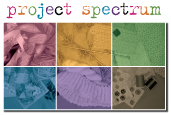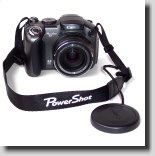
Our flower is now complete, but it needs a stem and some leaves. For this part of the project, hoop an extra light nonwoven stabilizer or some organza. I used painted Carriff stabilizer, but a green organza would work just as well. If you use stabilizer, you might want to paint it green with some fabric paint.
Set up your sewing machine for free motion work, making sure the feed dogs are in the lowered position. Attach a free motion or darning foot. Set your machine for straight stitching or a very slight zig zag stitch. Loosen the top tension a point or two and thread the machine with embroidery thread. I used Valdani Cotton Look #40. Of course, it’s always best to make a test sample before actually stitching your project.
Begin by stitching an outline of your leaf shape. Next, move up and down the center of the leaf.

Outline of leaf
Adjust your hoop so that you can stitch in a diagonal direction and then work one side of the leaf by stitching straight lines back and forth, making sure you stitch into the outlined edge. When that is complete, move to the next side and mirror image the diagonal stitching.

Now thread your machine with a dark green thread and stitch some veins on the surface of your leaf. Repeat the process for your second leaf.

Thread painted leaf with vein detail
When your leaves are completely stitched, set your hoop on a piece of glass. Heat up a stencil cutter or wood burning tool and move the point around the edges of your leaves. The stabilizer or organza should melt like butter, leaving you with two nonfraying leaves. Do this is a well ventilated area.


Heat tool removal of leaves
To create a stem for the flower, cut 5-6 lengths of green #3 or #5 perle cotton. Cut them about 2 inches longer than needed. Tape one end to secure all the threads.

Attach a cording foot to your sewing machine and thread the needle with embroidery thread. You can use the same thread in the bobbin. Choose a zig zag stitch and set the width at 4.5 – 5.5 mm. The feed dogs should be raised.

Now thread the taped end of your perle cottons through the hole in the cording foot. Sew over the threads, making sure your width clears each side. You can repeat this several times and even use different color threads with each pass.

Stitching over the perle cotton
Position your stem and leaves on the front of your project. You may like to tack them down here and there with a light dab of fabric glue. Using an open toe foot, couch your stem and sew a line of stitches up the middle of your leaves to secure them.

Couching the stem

Securing the leaves
Now position your flower and tack it down with a little fabric glue. You can blind stitch around the outer edges or tack the flower on with a few hand stitches from the back of your work.

At this point, I framed my piece with a wavy border using a fusible to attach it. For the finishing touch, I couched a #3 perle cotton around the inner frame using a braiding foot. These steps are optional, of course, but they do give the piece a nice finished look.

Another In Bloom project complete!
~~~~~~~~~~~~~~~~~~~~~~~~~~~~~~~
N. Rene West
Time Treasured































































































































